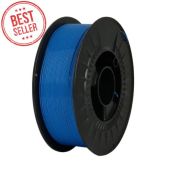We use cookies to make your experience better. Read more
PLA Filament Temperature: How to Achieve the Best Print Quality
Getting the PLA filament temperature just right is one of the most important aspects of successful 3D printing. Whether you're printing simple models or intricate, detailed designs, fine-tuning your temperature settings can drastically improve both the quality and reliability of your results. From bed adhesion to structural integrity, temperature affects almost every stage of the 3D printing process.
Why Temperature Matters in 3D Printing
Correct temperature settings are essential to melt the filament properly and ensure it flows smoothly through the nozzle. If the filament is too cold, it won’t extrude consistently. Too hot, and you might encounter stringing, blobs, or even structural defects.
- Layer adhesion
- Surface finish
- Print warping
- Print bed adhesion
- Nozzle flow rate
Each of these factors directly impacts the final look and strength of the printed object. For materials like PLA, the temperature range for the nozzle typically falls between 180-220°C, and the heated bed should stay around 60°C. However, optimal settings can slightly vary depending on the brand, filament color, and environment.
How PLA Filament Temperature Impacts Key Printer Parts
Extruder and Hotend
The extruder’s hotend is responsible for melting and extruding filament. If set too low, PLA doesn’t melt properly, resulting in under-extrusion or poor layer adhesion. Conversely, setting it too high causes oozing and stringing.
Heated Bed
The bed temperature ensures the first layer of your print sticks properly. For PLA, the ideal bed temperature is around 60°C. An under-heated bed can lead to warping, while too high a setting may soften the bottom layers excessively, causing deformities like elephant’s foot.
Nozzle
Nozzle temperature affects the consistency of filament extrusion. An overheated nozzle leads to strings and blobs, while an underheated one can clog and halt extrusion entirely. Precision becomes especially crucial when printing fine details.
Ideal PLA Temperature Ranges
- Nozzle temperature: 200–230°C
- Bed temperature: 60°C
Even within these ranges, small adjustments can make a big difference depending on your specific printer, slicer, and filament brand.
Identifying Common Temperature-Related Issues
- Under-extrusion: Caused by a low nozzle temperature; results in gaps and weak prints.
- Over-extrusion: Occurs when the temperature is too high; leads to strings and surface blobs.
- Poor bed adhesion: A bed that is too cool will not hold the print, leading to warping or shifting.
- Elephant’s foot: Happens when the bed is too hot; the base layer expands outward.
Practical Tips for Calibrating PLA Print Temperature
- Use Temperature Towers: Print test models at different temperature increments and examine each section for quality and consistency.
- Run Multiple Tests: Each filament brand (and even different colors) might behave differently. Test with small ±5°C increments.
Setting Temperatures in Popular Slicer Software
- Bambu Studio: Go to "Print Settings" > "Temperature" tab, set nozzle and bed temperatures, save and slice.
- Cura: Open "Material" tab, set "Printing Temperature" and "Build Plate Temperature", then slice.
- PrusaSlicer: Go to "Filament Settings", adjust nozzle and bed temperature, save and slice.
Fine-Tuning for Best Results
- Inspect layer bonding strength
- Check surface smoothness
- Look for strings or gaps
If your print is still not perfect, repeat the tower test, adjusting by smaller increments until you find the ideal temperature.
Adapting to Environment and Print Size
- Large prints: May require slightly higher bed temperatures (65–70°C)
- Small prints: Often work well with lower bed temps (55–60°C)
Additional Troubleshooting Tips
- Use painter’s tape or a PEI sheet
- Level and clean the bed before printing
- Use an enclosure to reduce drafts
- Use high-quality PLA filament
In Cura, use the “Horizontal Expansion” setting to compensate for filament shrinkage: Go to "Print Settings" > "Custom" panel > Enter values in "Horizontal Expansion" (e.g., +0.1 mm or -0.2 mm).
Understanding PLA Behavior and Material Specifics
- Biodegradability
- Low melting point
- Minimal odor
- Reduced warping and shrinkage
Each brand and even different filament colors can require specific tuning.
Cooling and Fan Settings
For PLA, part cooling is vital. Print the first layer without cooling for adhesion, then set the fan speed to 100% for the remaining layers to prevent sagging.
In Summary
- Better print quality
- Improved structural integrity
- Fewer failed prints
Although PLA is forgiving, attention to detail when calibrating your nozzle and bed temperature makes a huge difference. Always test with a temperature tower and take the time to adjust settings in your slicer accordingly.
If you're looking for high-quality thermoplastic processing or want advice on choosing the right filament material, 3D Trček is your trusted partner. Visit 3DTrcek.com to explore our range of services and solutions tailored to your needs.
Comment(s)



Please complete your information below to login.
Sign In
Create New Account